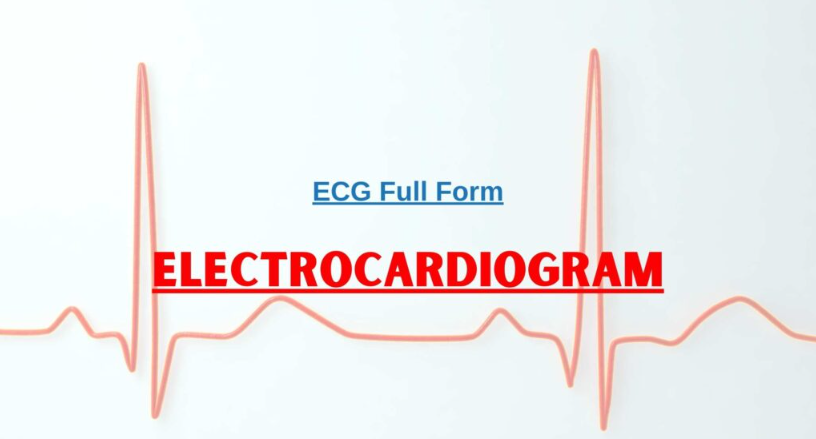
Most of us ask the question, what is the full form of ECG? Well, full form of ECG is an Electrocardiogram. It is a test that helps check how your heart works by testing its electrical activity. With each heartbeat, an electric wave passes through our heart. And because of this activity, our heart muscle pushes and allows blood to flow through the blood vessels. And with the help of an EKG, doctors can find out about heart health. Only a doctor can tell if your heart is healthy or not by measuring the electrical activity. If you have heart problems, you will most likely be referred to using the abbreviation EKG.
Why is ECG Done?
You may have blood clots due to an irregular heart rhythm. Therefore, it is essential to know whether your heart is functioning correctly or not. The abbreviation for EKG helps detect heart problems. With this test, you can tell if there is a blockage, muscle damage, or secondary inflammation in your heart. Therefore, you can be prepared to avoid any dangerous situations.
With an EKG test, the doctor can also determine if there is lung disease or an electrolyte imbalance. An EKG also helps you check the progress of your heart surgery or the development of a heart condition. If you have a pacemaker, an EKG can check its effectiveness for you. Hidden heart disease can also be detected with this test. ECG full form in medical is an electrocardiogram.
What is the Full Form of ECG?
The full form of ECG in English is an electrocardiogram. It refers to a test that measures the heart’s electrical activity to show whether the heart is functioning normally. An EKG records the rhythm and activity of the heart on a piece of paper or moving lines on a screen. ECG is one of the most commonly used medical tests to evaluate cardiovascular disease. It is an essential test for interpreting heart rhythm, detecting myocardial ischemia and infarction, conduction system abnormalities, hyperarousal, long QT syndrome, atrial abnormalities, ventricular hypertrophy, pericarditis, and other diseases.
An electrocardiogram (ECG) records the electrical impulses when the heart beats. In addition, these impulses are in the record on a moving piece of paper or on a screen, meaning they show the heart’s electrical activity as lines on the paper. The crests and valleys that appear on the contour are called waves. The ECG has three main components: the P wave, which represents atrial depolarization; the QRS complex, which represents ventricular depolarization; and the T waves, which represent ventricular repolarization.
What ECG Monitors
An EKG records the electrical impulses when the heart beats. These impulses are in the record on a moving piece of paper or on a screen, meaning they show the heart’s electrical activity as lines on the paper. The crests and valleys that appear on the contour are waves. So a regular ECG line is made up of waves that look like this:
P Wave
It is the first upward movement of the ECG. It shows the electrical activity of the upper auditory chamber.
QRS Complex
It consists of three waves, starting with a downward movement (Q), then a sizeable upward movement (R), and then a downward S wave. It shows the electrical activity of the lower chambers of the heart.
ST Segment
It looks like a straight line as the ventricle contracts without an electrical impulse.
T Wave
It is a moderate upward wave representing ventricular repolarization, H. when the heart’s lower chambers prepare for the next muscle contraction. Do you have heart problems? Rhythm, there is a deviation in the pattern or pulse diagram. It is a painless procedure. Moreover, placing electrodes on specific body parts such as arms, legs, or chest.
Does ECG have any Side Effects?
It is essential information for you where you can say that it is usually seen that the body does usually not face any harm by the ECG. Moreover, after removing the parts of the body where the electrodes were, swelling and a rash may appear. Let me tell you; those dumbbell monitors can irritate your skin if you don’t remove the electrodes daily. ECG test full form is an electrocardiogram test.
For What ECG is Done
Heart attack
An ECG is to check each patient’s possible heart attack. Moreover, it can see that the patient suffers from a heart attack that blocks blood flow, creating many opportunities for oxygen deprivation and death in the heart tissue.
Decreased Heart Size
It indicates that the heart valves are more significant than each other and that the heart is working harder than usual to pump blood.
Differences in Heart Rate
Everyone knows that the heart usually beats in a balanced rhythm. An EKG can show these changes if the heartbeats are in a rhythmic sequence. ECG ka full form hai electrocardiogram.
Benefits of ECG
One is often under the impression that ECG examinations are costly. But let me tell you, there’s nothing like it; it’s not that expensive or physically painful during testing. You can quickly get this test from any hospital within about 100 to ₹ 500.
Heart Rate
It refers to the time a person’s heart beats per minute. A regular heart rate is between 60 and 80 for men and 70 and 90 for women.
Heart Check
It is a practice where you can quickly diagnose heart problems. You can easily check if your heart is healthy or not. This process allows you to monitor your heart fully. So, friends, I hope this article about the complete ECG provides complete information about the ECG.
ECG Full Form in Hindi – ईसीजी क्या होता है
Full form of ECG in Hindi is ECG की फुल फॉर्म Electrocardiogram होती है. इसको हिंदी भाषा में विद्युतयंत्र द्वारा हृदय की धड़कनो का रेखाचित्रण कहते है. ECG एक तरह का Test होता है जिसमे मशीनो द्वारा दिल का Test किया जाता है. ECG Test मे दिल के विद्युत क्रियापाल का पता लगाया जाता है जैसे की – उच्च रक्तचाप, दिल का दर्द घबराहट, सांस की बीमारी, बेहोशी आदि ह्रदय से जुड़ी कई बिमारियों का पता लगाने के लिए ECG Test किया जाता है. इस Test से दिल से संबंधित कई बिमारियों का पता लगा कर उनको ठीक किया जा जाता है.


